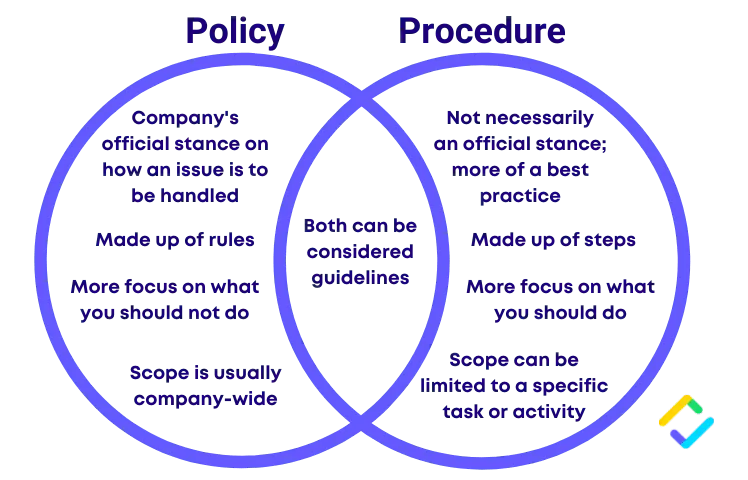What are Policies and Procedures?
Policies and procedures are guidelines that help shape company culture and employee behavior. They usually include lists of what is allowed, what is prohibited, and what should be done in certain scenarios. Both employees and managers are responsible for the success of policies and procedures.
Why are Policies and Procedures Important in the Workplace?
Policies and procedures are important in the workplace because they set the tone for how processes and activities are conducted in an organization. Ineffective policies and procedures can harm a company’s operations by adding unnecessary roadblocks to the actual execution and completion of work. The improper development of policies and procedures may also lead to a decline in the business’s reputation since these documents reflect the goals and values of the company.
What is a Policy?
A policy is defined as a comprehensive set of rules on a specific topic (such as a process, a situation, a group of people, or a particular environment). The overall purpose of policy creation is to establish protections against incidents that would disrupt the organization’s dynamic or workflow as well as the individual lives of employees.
What is a Procedure?
A procedure is defined as an ordered list of recommended steps for performing a task. Standard operating procedures, for instance, must be followed step-by-step to get the desired output (work that is on par with the organization’s quality and safety standards). Deviating at any step in the procedure may lead to unexpected outcomes with serious consequences.
Policy vs Procedure: What is the Difference?
The difference between policy and procedure is that policy requires organizations to take a stand or make a decision on how to approach a specific problem occurring in the workplace while procedure requires organizations to agree on how to perform a task for the best results.

Policy and Procedure Examples
Below are the various types of workplace policies and procedures:
Policies and Procedures for Attendance
Attendance policies and procedures specify the required working hours and times. For example, employees are required to work 8 hours a day from 9 am to 5 pm. These policies and procedures also include what counts as tardiness. For example, if the employee is in the building lobby at 9 am, but only gets to the office at 9:10 am, is it considered being tardy? Workplace managers will need to provide answers to these kinds of questions in the policies and procedures for attendance.
Policies and Procedures for Employee Conduct
Code of conduct policies and procedures are typically based on company values, which act as the guiding pillars for how employees at all levels should behave. In policies and procedures for employee conduct, it’s important to state what is appropriate and what is deemed unacceptable behavior. By clearly establishing the lines which employees should not cross, workplace managers will have less incidents concerning harmful or indecent behavior from employees.
Policies and Procedures for Use of Company Property
By company property, most organizations are referring to the physical (Information Technology) IT equipment and assets provided to employees to help them do their jobs. These are items such as computers, keyboards, headsets, and even laptops. But sometimes, company property can also refer to the software or the digital platforms and tools that employees need to use. Additionally, company property includes the physical office spaces (e.g., rooms and corridors) and the items within them (e.g., desks and whiteboards).
Policies and Procedures for Harassment and Discrimination
Harassment and discrimination in the workplace is a serious issue that needs active policies and procedures to stop them from happening. Though wider company culture issues need to be addressed, specific acts and behaviors displaying harassment or discrimination should be identified and strictly prohibited. Policies and procedures against harassment and discrimination should also be legally binding, acting as a deterrent and to prevent such incidents from being seen as trivial, merely internal, or just personal disagreements.
How to Develop Effective Policies and Procedures
A complete 5-step guide on developing effective policies and procedures—from writing to implementation:
Step 1: Define the Purpose of the Policy
Before policy writing, workplace managers should know exactly what they are writing about. For example, if the topic of the policy is gender-based discrimination, then the workplace manager or policy head should research on what that means, how it appears in the workplace, and its effects on employees and company culture.
Once the policy head has conducted sufficient research on the policy topic, they will need to propose the creation of the policy to company executives or the Human Resources (HR) department. The policy head should outline the following in their presentation:
- the current situation without the policy
- why the policy is needed and why is it needed now
- the intended goal of the policy (e.g., a safer workplace)
If the group of company executives or the HR department approves, then the policy head can start forming a policy development team and proceed to writing the policy draft.
Step 2: Write the Policy Using a Template
The reason why workplace managers should use a template when writing the policy and its procedures is that they don’t have to start from scratch. Using the same template for all policy writing also ensures that there is uniformity in the structure and format of the policies. Another reason why using a template is recommended for policy writing is that it’s easy to turn completed policies and procedures into compliance checklists that employees can go through on a daily basis.
However, even with a template, the policy head and other members of the policy development team should still be careful when writing the policy and its procedures. Keep in mind that a policy should have the following characteristics:
- Inclusive – Take the situations and perspectives of all employees into consideration.
- Clear – Be straightforward when stating what is and isn’t allowed since these are the basic facts employees will look for when reading the policy.
- Flexible – Leave room for improvement and adjustment. Policies are a work-in-progress and need to be regularly reviewed and revised.
When the actual policy writing is done, submit the policy draft to management (which can include company executives and/or HR) and to the company’s legal counsel for initial review and approval.
Explore our Free Policies and Procedures Templates
See how digital checklists simplify business processes with just a tap.
View nowStep 3: Prepare for Policy Implementation
Once all parties have approved of the policy draft and no further edits need to be made, the policy head can finalize it and begin preparing for implementation. For a successful implementation of the policy and its procedures, the policy head needs to do the following:
-
- Plan solutions for challenges to the policy’s implementation (internal and external constraints) as well as difficulties employees may have with carrying out procedures.
- Confirm management objectives when it comes to this particular policy and its procedures. Note down their expectations and identify what exactly needs to be done for the policy to meet or exceed those expectations.
- Create training and reference materials, including answers to questions employees may have regarding the policy, its background, and eventual implementation.
Step 4: Get Feedback and Assign Enforcers
The policy development team must hold an orientation for the employees covered by the policy. It should introduce the policy and train employees on how to comply with the policy. Ideally, there should be a Question & Answer (Q&A) session after the orientation so that the policy development team can get the initial feedback from employees.
If the concerns of employees are too great or severely show the deficiencies of the policy, then the policy head must consider rewriting or revising the policy or even withdrawing it (i.e., the policy will no longer be implemented or will be put on hold indefinitely).
But if feedback is mostly positive, the policy head can set a date for implementation and already assign policy enforcers who will be responsible for checking if the employees are complying with the policy and for informing the policy head of any violations.
Step 5: Implement and Improve on the Policy
Though at this point, the policy head has already gotten some feedback on the policy from the employees concerned, there is a difference between reading the policy and actually seeing it in action. That’s why even during and after implementation, employee feedback should still be collected and analyzed to make further improvements on the policy.
New policies (i.e., those that did not exist previously) should be reviewed and revised 3 months after implementation by the policy development team. If the new policy is deemed a success, then its next review and revision date can be set to after 6 months. If the policy is still effective at that time (total of 9 months after implementation), then it can be reviewed and revised annually by a dedicated policy review team.
Train Employees on Compliance with Policies and Procedures
Building a culture of workplace safety and compliance isn’t a walk in the park. Policies and procedures set out the rules and guidelines that your workers should follow to secure workplace efficiency as well as guarantee everyone’s health and safety. And the best way to engrain these guidelines into your workers is by putting together robust training.
With good policies and procedures training, you can effectively reinforce the best practices outlined in your policies and procedures, and help your workers become more aware of how to effectively execute their work.
Creating effective training is quick and easy – as long as you have the right tool in hand. For that, try SafetyCulture (formerly iAuditor)’s Training. With its drag-and-drop function, you can easily turn your policy and procedures into beautiful and engaging slides – and in just minutes.
Free Tool to Help You with Policies and Procedures
SafetyCulture is a policy management software, offering a free version with most of its core features that could help in policy writing and implementation.
Discover what you can do with SafetyCulture for free:
- Write policies and procedures – Add photos and notes to bring your policies and procedures to life. Assign actions to other members of the policy development team. Ask company executives and HR personnel to digitally sign the policy draft for approval.
- Distribute policies and procedures – After completing a policies and procedures template, get a shareable web report link, download it as a PDF, or immediately send it via email without leaving SafetyCulture.
- Implement policies and procedures – Copy items from a completed policies and procedures template and paste them into a new compliance checklist template as questions with the response type of Compliant/Non-Compliant. Make this new template accessible to intended employees.
Get started with SafetyCulture for free or learn more about the premium plan features.



